
SAVE THESE INSTRUCTIONS FOR FUTURE USE
Motor
Be sure your power supply agrees with the nameplate marking. Voltage decrease of more than
10% will cause loss of power and overheating. D
EWALT tools are factory tested; if this tool does
not operate, check power supply.
COMPONENTS (FIG. 1, 2, 3)
WARNING: Never modify the power tool or any part of it. Damage or personal injury could result.
A. Trigger switch
B. Reversing lever
C. Bubble level
D. Bubble level bulls-eye
E. Keyless chuck
Keyed chuck (not shown)
INTENDED USE
These heavy-duty V.S.R. drills are designed for professional drilling at various work sites (i.e.,
construction sites). DO NOT use under wet conditions or in presence of flammable liquids or gases.
These heavy-duty V.S.R. drills are professional power tools. DO NOT let children come into contact
with the tool. Supervision is required when inexperienced operators use this tool.
Switches (Fig. 1)
To start the drill, depress the trigger switch; to stop the drill, release the trigger.
A variable speed trigger switch (A) permits speed control—the farther the trigger is depressed, the
higher the speed of the drill.
NOTE: Use lower speeds for starting holes without a center punch, drilling in metal or plastics,
driving screws or drilling ceramics. Higher speeds are better for drilling wood and composition
boards and using abrasive and polishing accessories.
The reversing lever (B) is used for withdrawing bits from tight holes and removing screws. It is
located above the trigger switch. To reverse the motor, release the trigger switch FIRST and then
push the lever to the right. After any reversing operations, return lever to forward position.
OPERATION
WARNING: To reduce the risk of injury, turn unit off and disconnect it from power
source before installing and removing accessories, before adjusting or when making
repairs. An accidental start-up can cause injury.
Drilling
WARNING: To reduce the risk of personal injury, ALWAYS ensure workpiece is anchored
or clamped firmly. If drilling thin material, use a wood “back-up” block to prevent damage to the
material.
1. Use sharp drill bits only. For WOOD, use twist drill bits, spade bits, power auger bits, or hole
saws. For METAL, use steel twist drill bits or hole saws. For MASONRY, such as brick, cement,
cinder block, etc., use carbide-tipped bits rated for percussion drilling.
2. Always apply pressure in a straight line with the bit. Use enough pressure to keep drill biting,
but do not push hard enough to stall the motor or deflect the bit.
3. Hold tool firmly with both hands to control the twisting action of the drill.
4. IF DRILL STALLS, it is usually because it is being overloaded or improperly used. RELEASE
TRIGGER IMMEDIATELY, remove drill bit from work, and determine cause of stalling. DO
NOT CLICK TRIGGER ON AND OFF IN AN ATTEMPT TO START A STALLED DRILL —
THIS CAN DAMAGE THE DRILL.
5. To minimize stalling or breaking through the material, reduce pressure on drill and ease the bit
through the last fractional part of the hole.
6. Keep the motor running when pulling the bit back out of a drilled hole. This will help prevent
jamming.
7. With variable speed drills there is no need to center punch the point to be drilled. Use a slow
speed to start the hole and accelerate by squeezing the trigger harder when the hole is deep
enough to drill without the bit skipping out.
DRILLING IN METAL
Start drilling with slow speed and increase to full power while applying firm pressure on the tool.
A smooth even flow of metal chips indicates the proper drilling rate. Use a cutting lubricant when
drilling metals. The exceptions are cast iron and brass which should be drilled dry.
NOTE: Large [5/16" (8 mm) to 1/2" (13 mm)] holes in steel can be made easier if a pilot hole [5/32"
(4 mm) to 3/16" (5 mm)] is drilled first.
DRILLING IN WOOD
Start drilling with slow speed and increase to full power while applying firm pressure on the tool.
Holes in wood can be made with the same twist drills used for metal. These bits may overheat
unless pulled out frequently to clear chips from the flutes. Work that is apt to splinter should be
backed up with a block of wood.
DRILLING IN MASONRY
When drilling in masonry, use carbide-tipped bits rated for percussion drilling and be certain that
the bits are sharp. Use a constant and firm force on the tool to drill most effectively. A smooth, even
flow of dust indicates the proper drilling rate.
Bubble Level (Fig. 2)
Your drill is equipped with a bubble level (C) that assists you in drilling level holes.
For horizontal drilling, tilt the drill up or down as required so that the bubble floats in the center of
the parallel lines drawn on the glass. When the bubble is centered between the lines, the drill is level.
For vertical drilling, align the drill so that the bubble floats in the center of the bull’s-eye (D).
To assure accuracy, first place a level on your work piece and position it so that it is level. Then,
when the drill reads level, the two will be aligned. (Any bubble level can only indicate level to the
earth’s surface).
NOTE: The fluid in the bubble level vial is mineral spirits. If the mineral spirits gets into your eyes,
flush eyes with water. If irritation occurs, seek medical attention. If the vial fluid comes into contact
with your skin, remove contaminated clothing and remove excess fluid. Rinse thoroughly with water
followed by washing with soap and water. If irritation occurs, seek medical attention. If vial fluid is
inhaled, immediately get fresh air. If difficulty breathing, seek medical attention.
Keyless Chuck (Fig. 3)
Your tool features a keyless chuck (E) for greater convenience. To insert a drill bit or other accessory,
follow the steps listed below.
1. Grasp the rear half of the chuck with one hand and use your other hand to rotate the front
half counterclockwise, as shown in Figure 3. Rotate far enough so that the chuck opens
sufficiently to accept the desired accessory.
2. Insert the bit or other accessory about 3/4" (19 mm) into the chuck and tighten securely by
holding the rear half of the chuck and rotating the front portion in the clockwise direction. When
the chuck is nearly tightened, you will hear a clicking sound. After 4–6 clicks, the chuck is
securely tightened around the accessory.
3 To release the accessory, repeat step 1 listed above.
WARNING: Do not attempt to tighten drill bits (or any other accessory) by gripping the front part
of the chuck and turning the tool on. Damage to the chuck and personal injury may result.
KEYLESS CHUCK REMOVAL (FIG. 4)
Tighten the chuck around the shorter end of a hex key (not supplied) of 1/4" (6 mm) or greater size.
Using a soft hammer or piece of wood, strike the longer end in the counterclockwise direction. This
will loosen the chuck so that it can be unscrewed by hand.
KEYLESS CHUCK INSTALLATION (FIG. 5)
Screw the chuck on by hand as far as it will go. Tighten the chuck around the shorter end of a
1/4" (6 mm) or larger hex key (not supplied) strike the longer end in the clockwise direction with a
soft hammer.
MAINTENANCE
WARNING: To reduce the risk of injury, turn unit off and disconnect it from power
source before installing and removing accessories, before adjusting or when making
repairs. An accidental start-up can cause injury.
FIG. 5
FIG. 4
FIG. 2
C
D
Cleaning
WARNING: Blow dirt and dust out of all air vents with clean, dry air at least once a week. To
minimize the risk of eye injury, always wear ANSI Z87.1 approved eye protection when performing
this.
WARNING: Never use solvents or other harsh chemicals for cleaning the non-metallic parts
of the tool. These chemicals may weaken the plastic materials used in these parts. Use a cloth
dampened only with water and mild soap. Never let any liquid get inside the tool; never immerse
any part of the tool into a liquid.
Motor Brushes
DEWALT uses an advanced brush system which automatically stops the drill when the brushes
wear out. This prevents serious damage to the motor. New brush assemblies are available at
authorized D
EWALT service centres. Always use identical replacement parts.
Lubrication
When the tool is taken apart for motor brush replacement a small amount of grease should be
added (or redistributed from that remaining in housing) to the gears. The ball bearings used in this
tool are lubricated during manufacture and require no lubrication.
Repairs
To assure product SAFETY and RELIABILITY, repairs, maintenance and adjustment (including brush
inspection and replacement) should be performed by a D
EWALT factory service center, a DEWALT
authorized service center or other qualified service personnel. Always use identical replacement
parts.
Accessories
WARNING: Since accessories, other than those offered by DEWALT, have not been tested with
this product, use of such accessories with this tool could be hazardous. To reduce the risk of injury,
only D
EWALT recommended accessories should be used with this product.
Recommended accessories for use with your tool are available at extra cost from your local dealer or
authorized service center. If you need assistance in locating any accessory, please contact D
EWALT
Industrial Tool Co., 701 East Joppa Road, Baltimore, MD 21286, call 1-800-4-D
EWALT (1-800-433-
9258) or visit our website: www.dewalt.com.
CAUTION: To reduce the risk of injury, the following accessories should be used only in sizes up
to the maximums shown in the table below.
MAXIMUM RECOMMENDED CAPACITIES
Drill capacity 3/8" (10 mm)
R.P.M. 0-2500
Bits, metal drilling 3/8" (10 mm)
Wood, flat boring 1" (25.4 mm)
Bits, masonry drilling 1/2" (12.7 mm)
Hole saws 1-1/8" (28.4 mm)
ACCESSORY MUST BE RATED FOR USE AT SPEED EQUAL TO OR HIGHER THAN NAMEPLATE
R.P.M. OF TOOL WITH WHICH IT IS BEING USED.
Wire wheel brushes 4" (101.6 mm) diameter maximum
Wire cup brushes 3" (76.2 mm) diameter maximum
Buffing wheels 3" (76.2 mm) diameter maximum
Rubber backing pads 4-5/8" (117.4 mm) diameter maximum
Register Online
Thank you for your purchase. Register your product now for:
• WARRANTY SERVICE: Registering your product will help you obtain more efficient warranty
service in case there is a problem with your product.
• CONFIRMATION OF OWNERSHIP: In case of an insurance loss, such as fire, flood or theft,
your registration of ownership will serve as your proof of purchase.
• FOR YOUR SAFETY: Registering your product will allow us to contact you in the unlikely event
a safety notification is required under the Federal Consumer Safety Act.
Register online at www.dewalt.com/register.
Three Year Limited Warranty
DEWALT will repair, without charge, any defects due to faulty materials or workmanship for three
years from the date of purchase. This warranty does not cover part failure due to normal wear or tool
abuse. For further detail of warranty coverage and warranty repair information, visit www.dewalt.
com or call 1-800-4-D
EWALT (1-800-433-9258). This warranty does not apply to accessories or
A
B
FIG. 1
FIG. 3
E

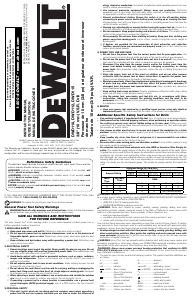


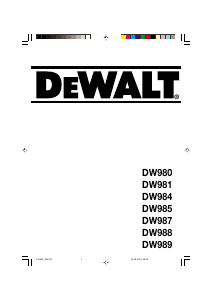
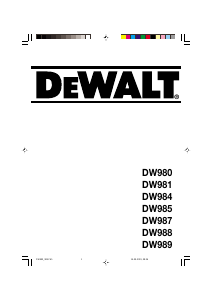
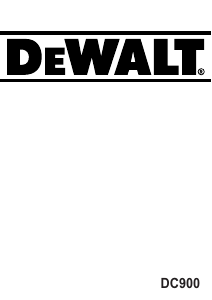
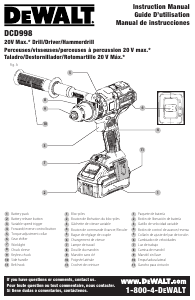

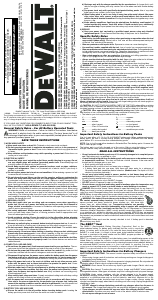
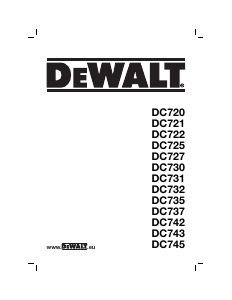
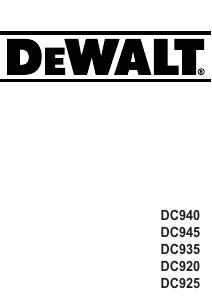
Únase a la conversación sobre este producto
Aquí puedes compartir lo que piensas sobre DeWalt DWD115K Atornillador taladrador. Si tiene alguna pregunta, primero lea atentamente el manual. Puede solicitar un manual utilizando nuestro formulario de contacto.